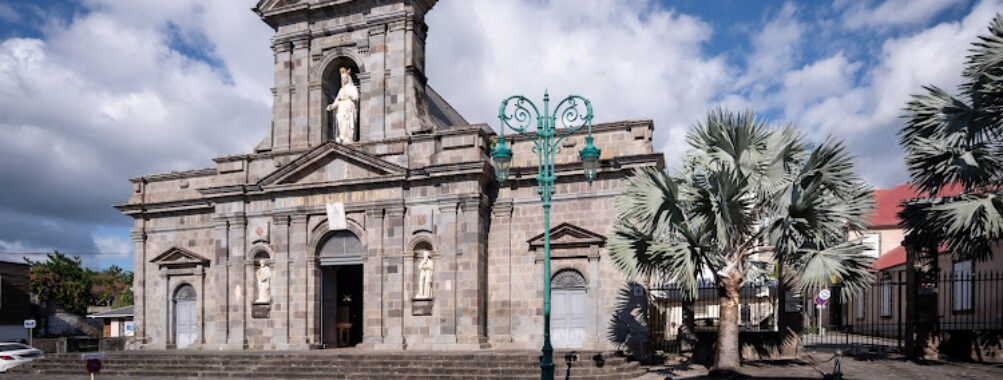
Cathédrale Notre-Dame de Guadeloupe
“`html
Table of Contents
Description
Cathédrale Notre-Dame de Guadeloupe in Basse-Terre is one of those places that immediately makes you pause, even if you weren’t planning to. It’s not just another church—it’s the cathedral that holds centuries of history, faith, and island identity within its walls. Built originally in the 18th century by French Jesuits, the site has seen reconstructions, hurricanes, and the slow but steady layering of culture that makes Guadeloupe what it is today. Walking up to it, the stone façade feels both sturdy and weathered, like it has stood guard over the town through countless storms. Inside, the wooden vaulted ceiling gives the space a warmth you don’t always expect in a cathedral, and it’s surprisingly intimate for a building of such importance.
What makes it special is that it’s not just a monument—people still come here daily for worship, reflection, and quiet moments. It’s the seat of the Diocese of Basse-Terre and Pointe-à-Pitre, which means it’s the center of Catholic life on the island. But even if you’re not religious, the artistry and atmosphere are worth experiencing. The decorative silver and gold objects inside, some dating back to the 1700s, are fascinating to see up close. And honestly, there’s something grounding about standing in a place where so many generations have gathered before you. It’s beautiful without being overly polished, and that authenticity is what makes it memorable.
Key Features
- A Roman Catholic cathedral dedicated to Our Lady of Guadalupe
- Originally built in 1736 on the site of an earlier 17th-century chapel
- Designated as a national monument of France
- Wooden vaulted ceiling that creates a warm, welcoming interior
- Collection of historic religious objects: ciborium (1748), chalice and tray (1750), monstrance (1704, restored in 1920)
- Seat of the Diocese of Basse-Terre and Pointe-à-Pitre since 1850
- Blend of colonial architecture and Caribbean resilience
Best Time to Visit
If you’re planning your trip, timing matters more than you’d think. The cathedral is open year-round, but mornings are especially peaceful. The light filters through in a way that makes the interior glow, and you’ll often find fewer people around. Sundays are busy, of course, with services drawing locals from all over. If you’re curious about experiencing the cathedral as a living place of worship, attending Mass can be moving, even if you don’t understand every word in French or Creole.
Weather-wise, the cooler months from December to April are ideal for exploring Basse-Terre in general. The heat and humidity of summer can make walking around town a bit sticky, and the cathedral doesn’t have air conditioning. But honestly, even in the warmer months, stepping inside feels like a break from the sun. I once visited in late July, and while I was practically melting outside, the cathedral’s thick stone walls kept the interior surprisingly comfortable.
How to Get There
Reaching the cathedral is straightforward if you’re already in Basse-Terre. It sits right in the heart of town, so you can easily explore it on foot while checking out the surrounding streets, markets, and cafés. If you’re coming from Pointe-à-Pitre or another part of the island, you’ll likely need to rent a car or take a bus. The drive along the coast is scenic, with stretches of turquoise water on one side and lush mountains on the other. Parking in Basse-Terre can be a little tricky, but there are usually spots within a short walk.
For those who enjoy a bit of wandering, I’d recommend arriving early and strolling through the town before heading to the cathedral. It’s a good way to soak up the rhythm of local life, and you’ll probably stumble across a bakery or fruit stand worth stopping at. And if you’re like me, you’ll want to grab a pastry before heading inside—it makes the whole experience feel more like a day out than just a quick stop.
Tips for Visiting
A few practical things can make your visit smoother. First, dress modestly. It’s still an active place of worship, and while tourists are welcome, showing respect goes a long way. Shoulders covered, hats off—that sort of thing. Second, check ahead if you want to attend a service since times can shift around holidays and feast days.
Photography is allowed, but try to be discreet. I’ve seen people snapping selfies during Mass, and it felt awkward for everyone involved. If you want to capture the details, do it when the cathedral is quiet. Also, bring a small bottle of water. The Caribbean sun is no joke, and while the cathedral offers shade, you’ll probably be walking around the town before or after.
One last tip: linger. Don’t just pop in, take a photo, and leave. Sit for a few minutes on one of the wooden pews, let your eyes wander over the ceiling, and just listen. You’ll hear footsteps echoing, maybe a whispered prayer, maybe just the creak of the old wood. It’s in those quiet moments that the cathedral really reveals itself.
“`
Location
Places to Stay Near Cathédrale Notre-Dame de Guadeloupe
Find and Book a Tour
Explore More Travel Guides
No reviews found! Be the first to review!